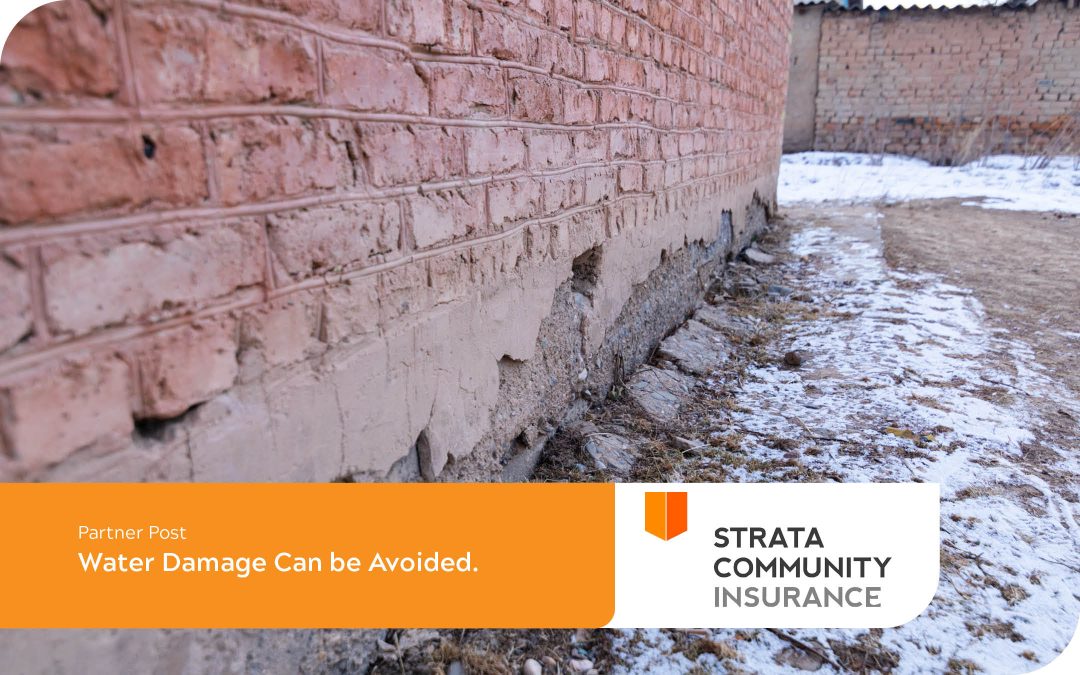Strata buildings are complex structures with key components like water pipes, electrical wiring, air-conditioning systems, ventilation and lift systems in place.
Much of this infrastructure is hidden out of sight either in cavity walls, cupboards, roof spaces or under flooring so it does not upset the aesthetic appearance of a strata property, apartment or lot.
When something goes wrong with these components, the resultant damage increases exponentially.
Water damage claims
Water damage is one of the most common causes of strata insurance claims. Significant claims may have an impact on insurance premiums on renewal. The key is to minimise claims with a regular maintenance/prevention regime in place both at the building and lot owner level.
At Strata Community Insurance just under 70% of claims raised relate to water damage. Many of these claims could have been avoided with a good preventative maintenance program and regular verification of the working order of the key components in the strata complex and within individual apartments/lots.
Physical evidence of a water problem
The intent of strata insurance is to cover claims for water damage that is sudden and accidental. In many instances, strata insurance will cover the hidden perils of burst or leaking pipes when physical evidence of damage is first noticed and a claim is made.
Strata insurance does not cover poor maintenance where a known problem has been allowed to continue and expand over time, nor does it cover wear and tear. Water problems may not be noticed until there is physical evidence like mould, dampness or leakages. At that stage of discovery, in our experience, the impact will be greater and, in many instances, will have spread to multiple apartments/lots and common areas.
Over the past three years, Strata Community Insurance paid out more than $50 million in water damage claims. Many could have been avoided with a good preventative maintenance programme.
Impact is not just payment of an insurance claim
Having a claim paid can often be the easy part. A significant impact on strata committees, owner/occupiers and tenants is the time lost after lodgement and payment of a claim and additional out-of-pocket expenses – particularly if appropriate contents insurance is not in place. Of course, this scenario does not take into account the time, effort and expense relating to:
- Phone calls, emails and time lost waiting on suppliers to turn up (or not) to quote for repairs.
- Time lost waiting on repair work to commence.
- Impact on lifestyle/living conditions of repair work, with removal of walls, ceilings, and roofs to rectify damage.
- Inability for people to remain in their home due to the extent of repair work required, especially if the apartment/lot is unfit to be occupied for a considerable length of time (3+ months living out of a suitcase).
- Electrical repairs.
- Matching/replacing paint, tiles, bathroom fittings, kitchen fittings.
- Impact of common area repairs and access to the building.
- Out-of-pocket expenses to repair and replace items not covered by insurance.
Prevention is better than cure
A good maintenance program and regular verification will help identify significant risk areas both seen and unseen in a strata complex. For example, key points that should be considered:
- Is the building experiencing bursting pipes?
- Is the building more than 30 years old?
- Does the water need to be filtered for drinking?
- Hidden pipes may not be capable of being inspected, but can be tested. Further, water purity can be tested.
Where water pressure is a concern, strata committees should consider the installation of pressure limiting valves at the mains to reduce the water pressure going into a building. These valves will reduce the pressure on water pipes and joints, and may extend their life by up to an additional 5-7 years.
Corrosive impurities have been found in water across Australia and, over time (approximately 30–40 years), will cause even copper pipes to fail.
Apartment/lot owners also have a part to play in checking their internal fixtures and fittings, and replacing items that are showing signs of age, wear and tear.
Signs of mould in areas outside of bathrooms or kitchens are a good indicator of a plumbing problem and should be investigated. Flexible hoses in bathrooms or kitchens should be checked regularly and replaced if showing signs of degradation. Shower membranes showing signs of wear and tear should be repaired or replaced.
Examples of water damage
Common gradual water damage causes include:
- Plumbing, taps or pipes leaking – causing damage to the walls, ceilings or floors.
- Flashing, tiles, shingles or deteriorating roof parts – indicating signs of needed repair.
- Mould, rot or corrosion caused by long-term water seepage.
- Deteriorating electrical wiring caused by water seepage.
- Seepage from cracks in foundations or at the exterior of the building allowing water to enter the strata complex.
- Poor repairs or lack of repairs to the strata complex.
- Flexi hose issues. The maximum lifespan of flexi hoses is generally 10 years or less.
To find out more or read example case studies regarding this topic, please visit https://bmp.efd.myftpupload.com/water-damage-can-be-avoided/
